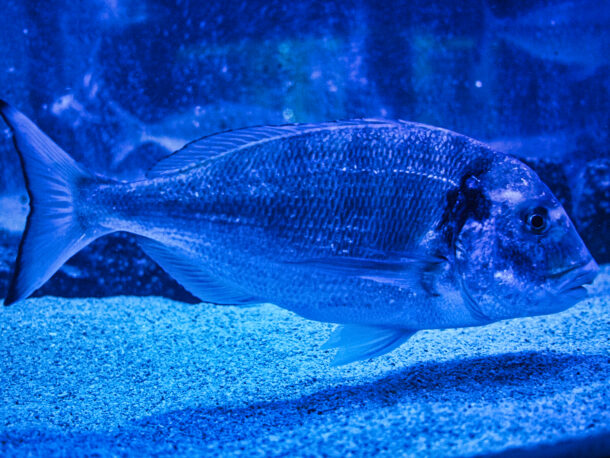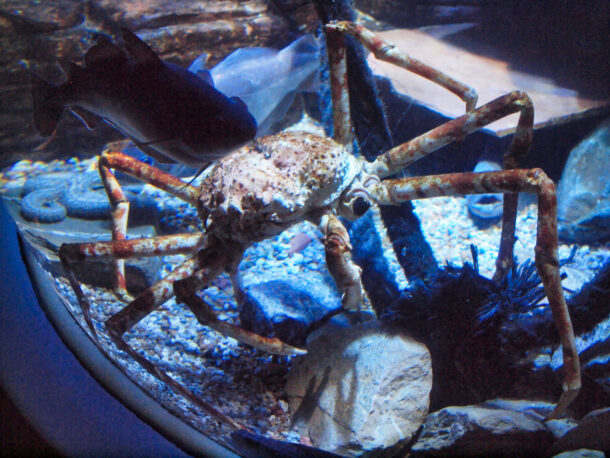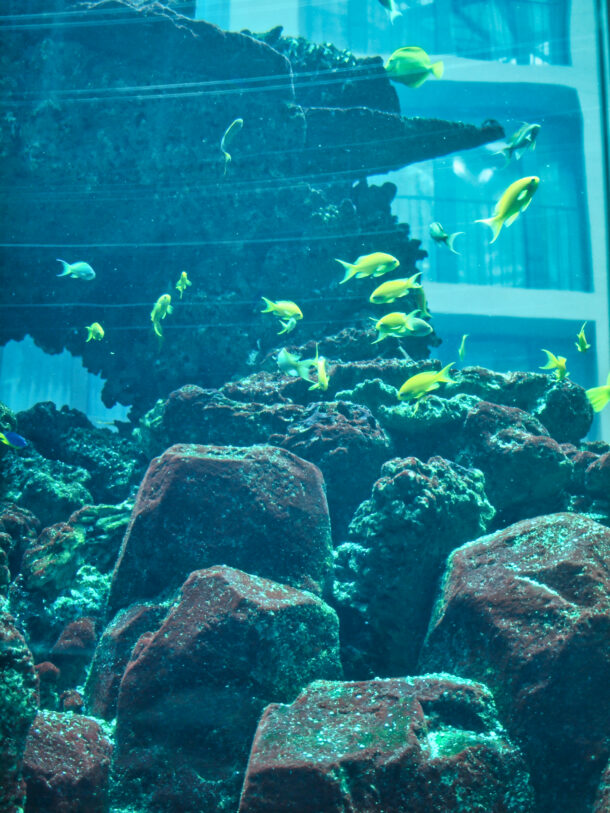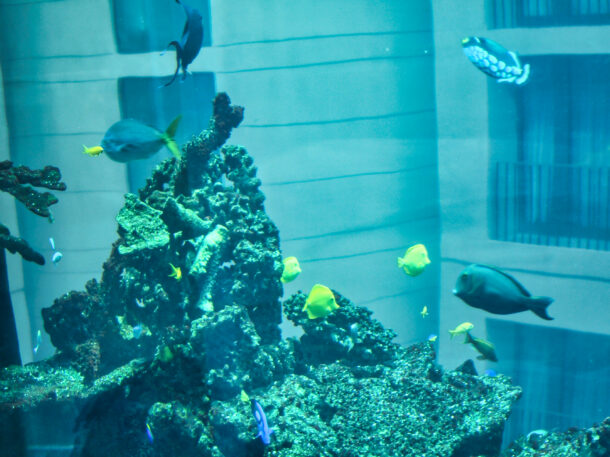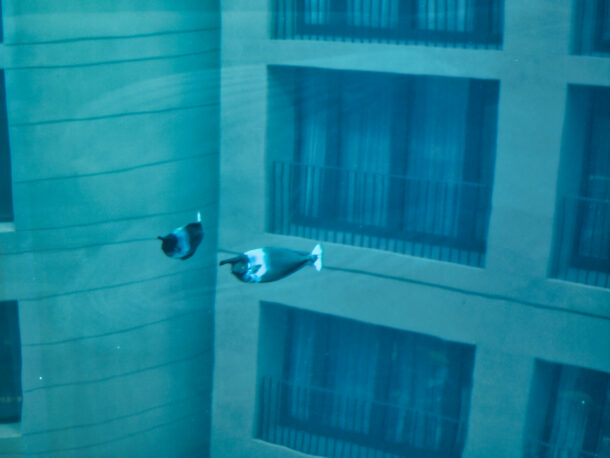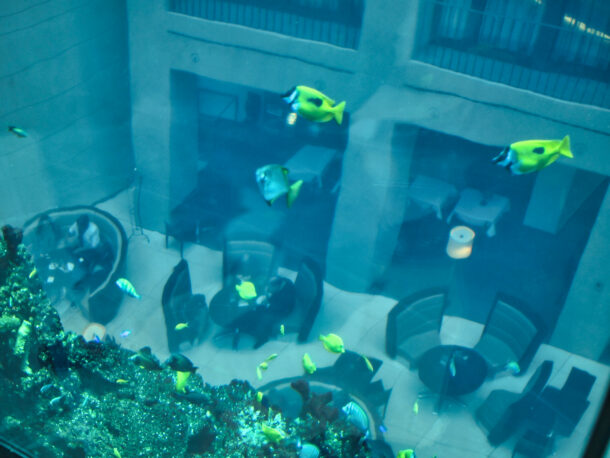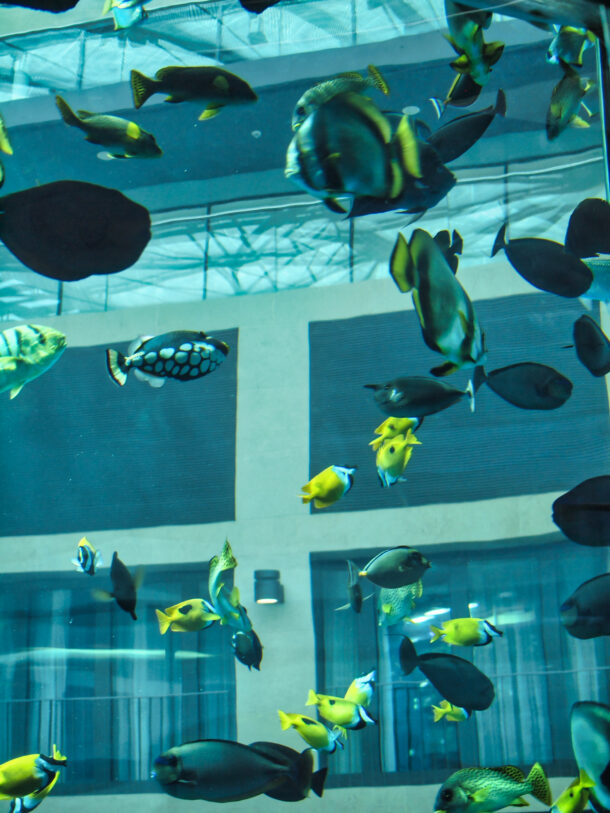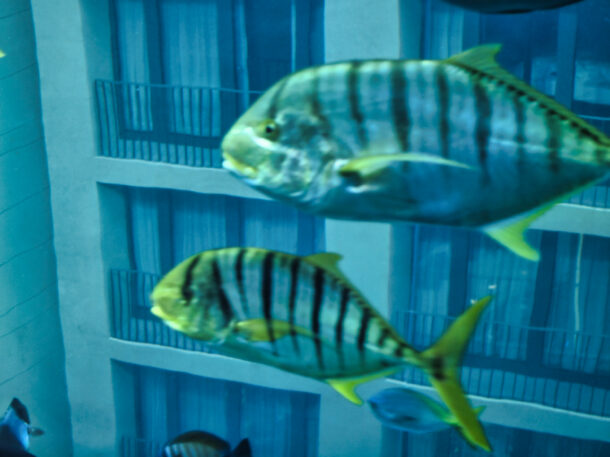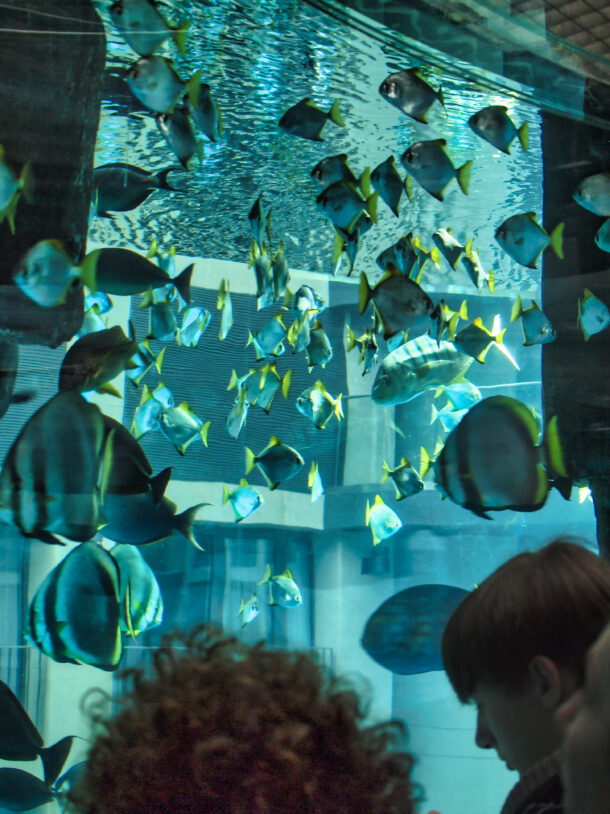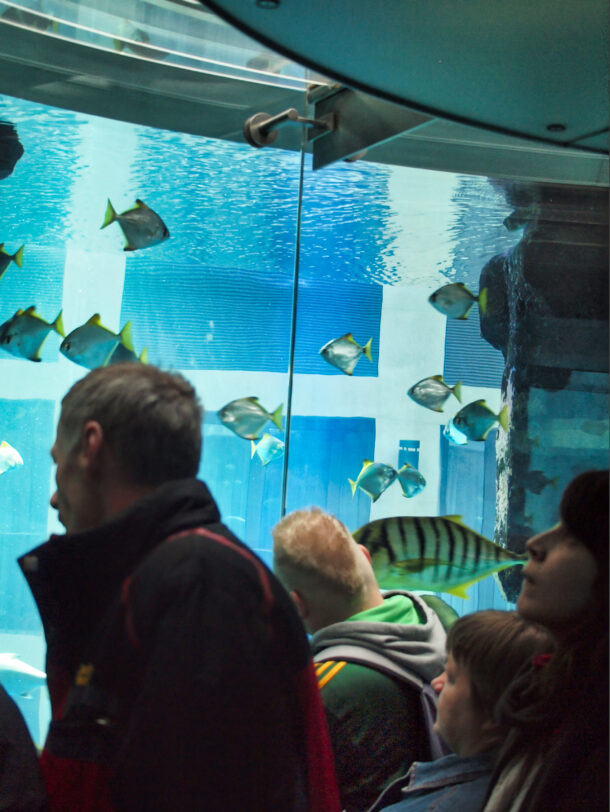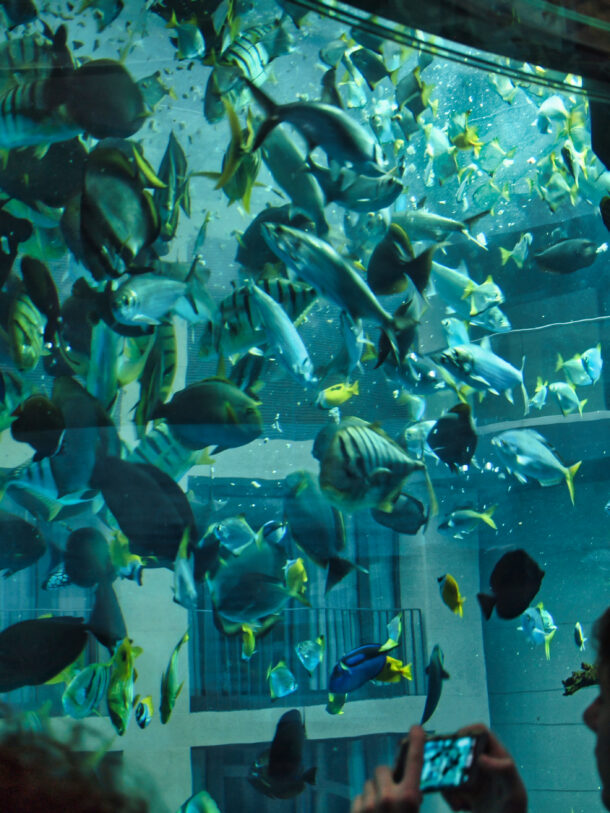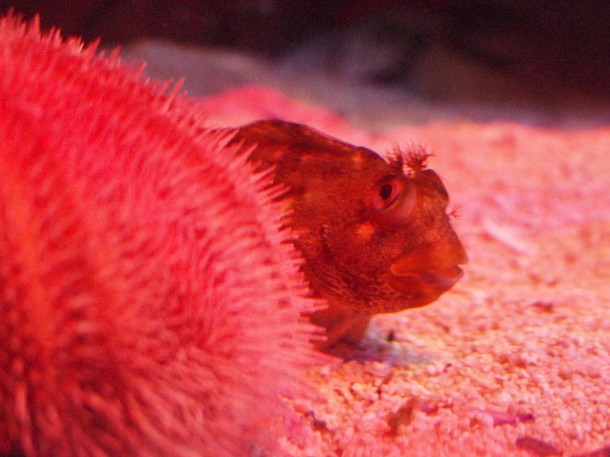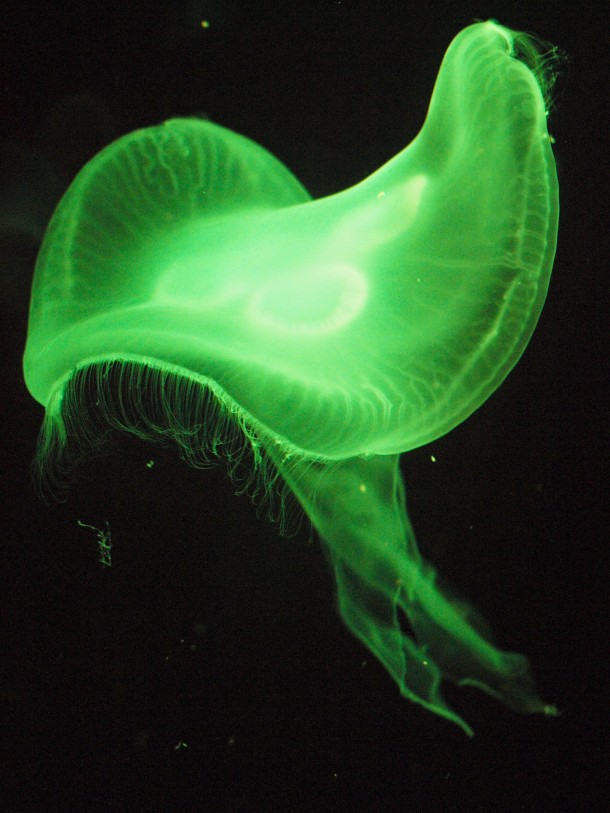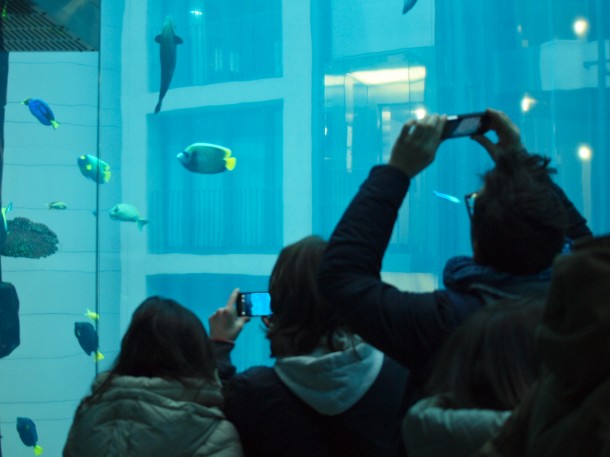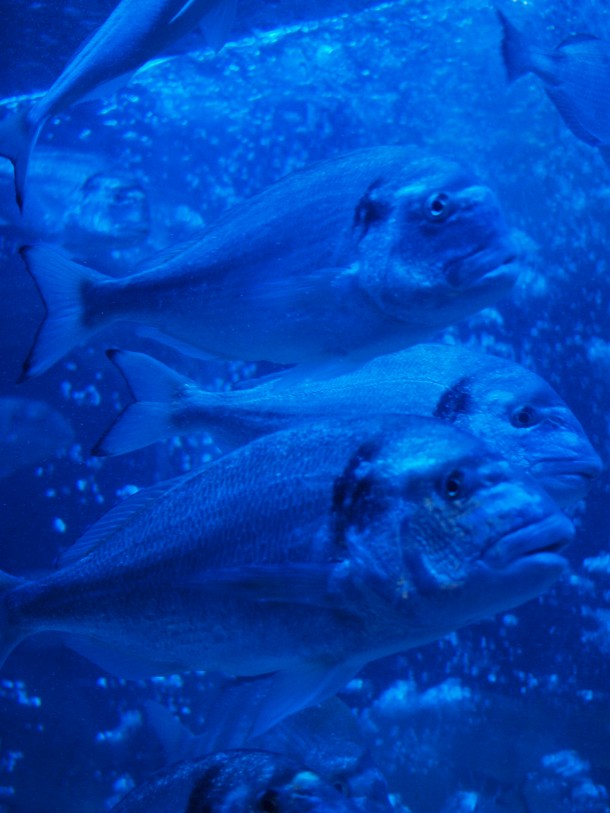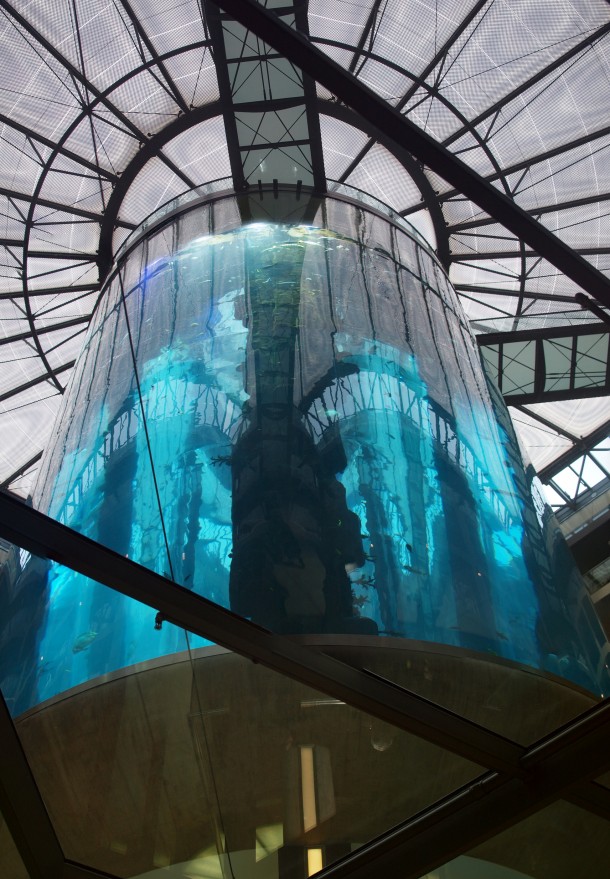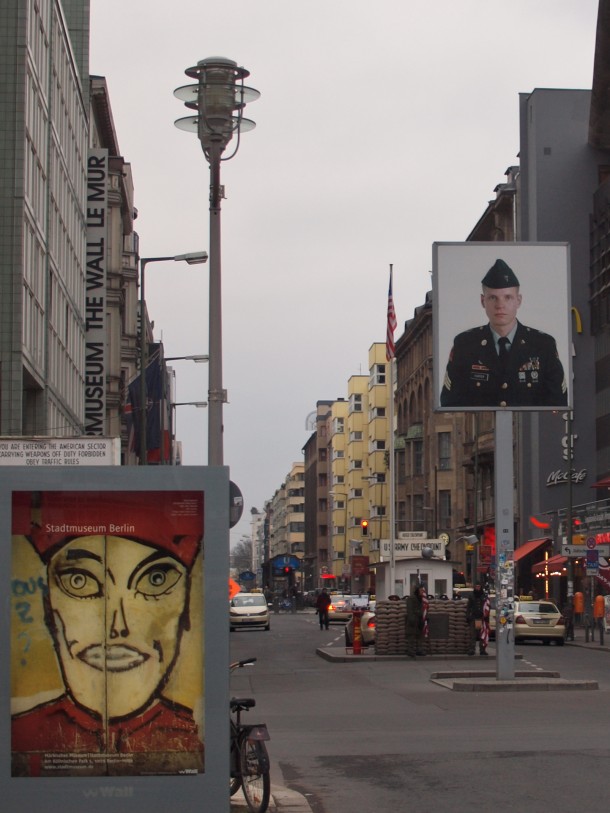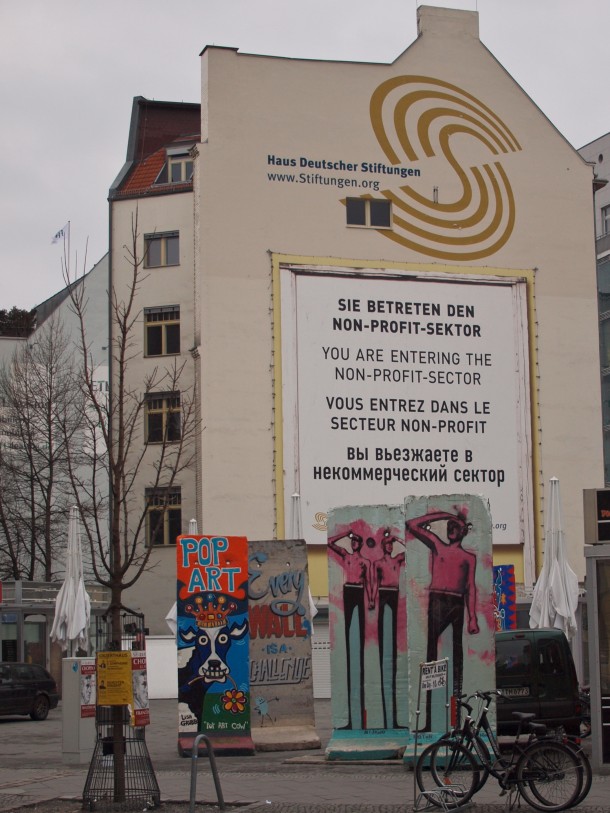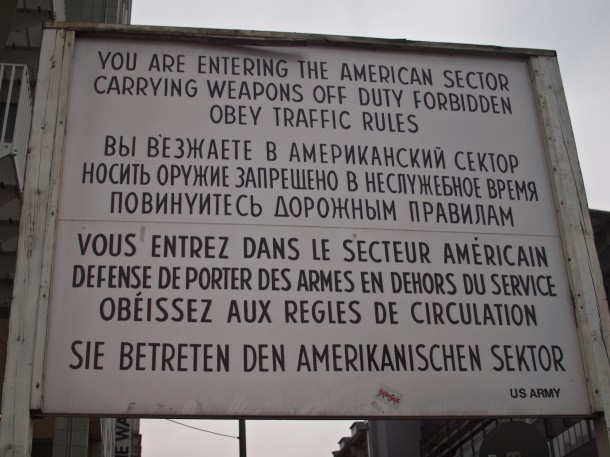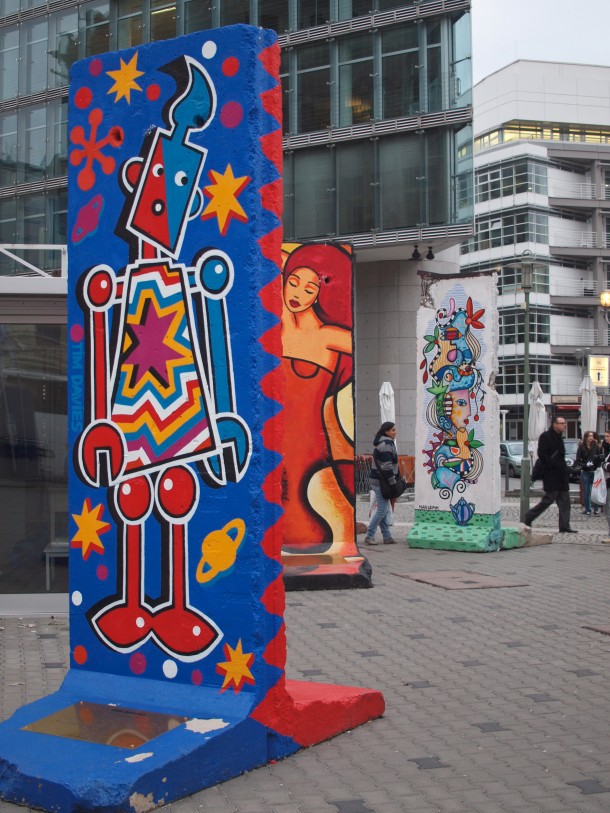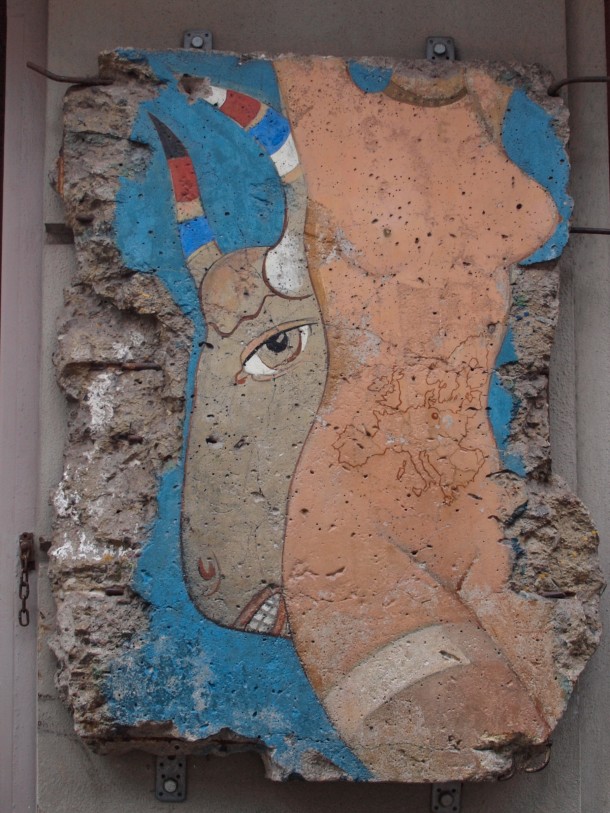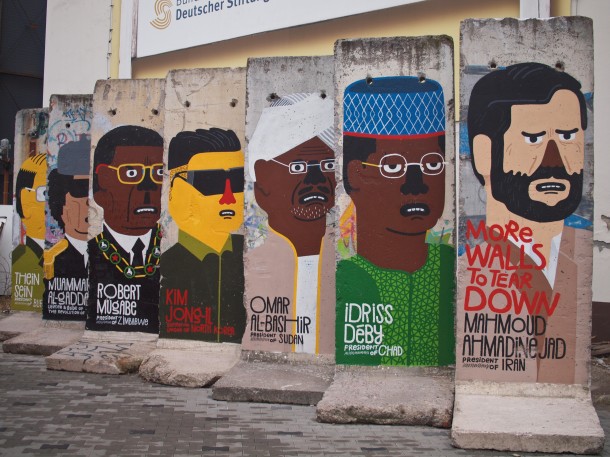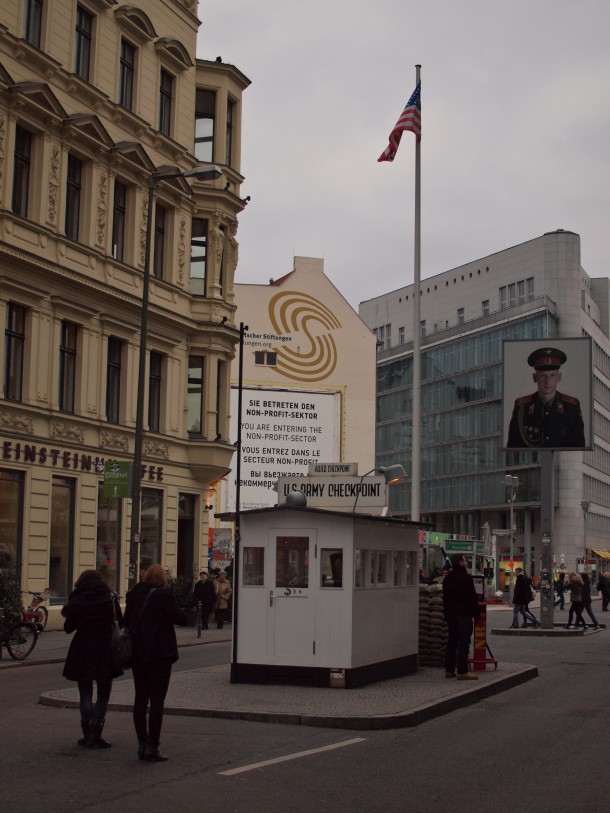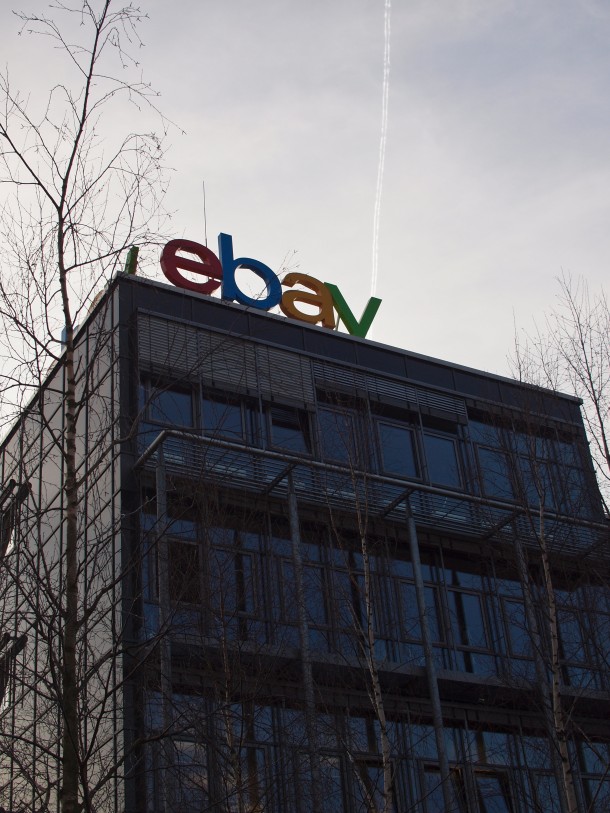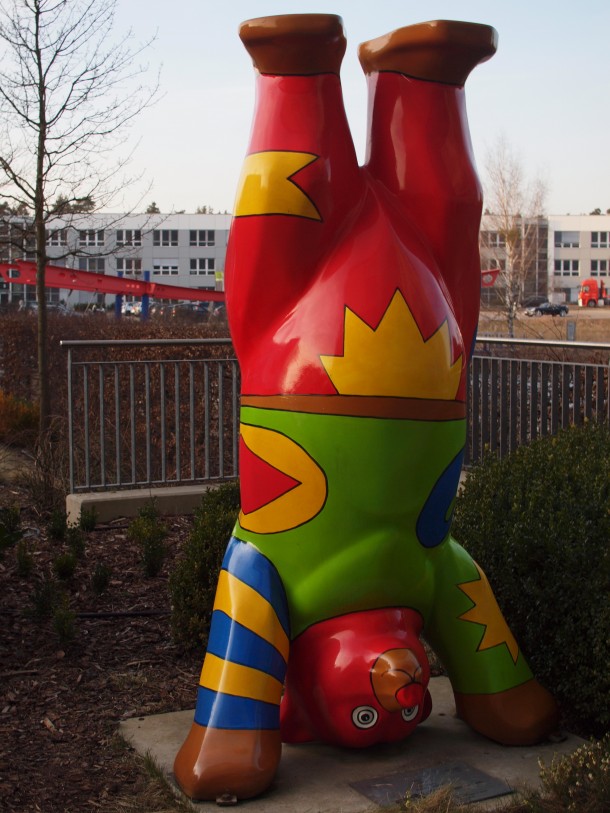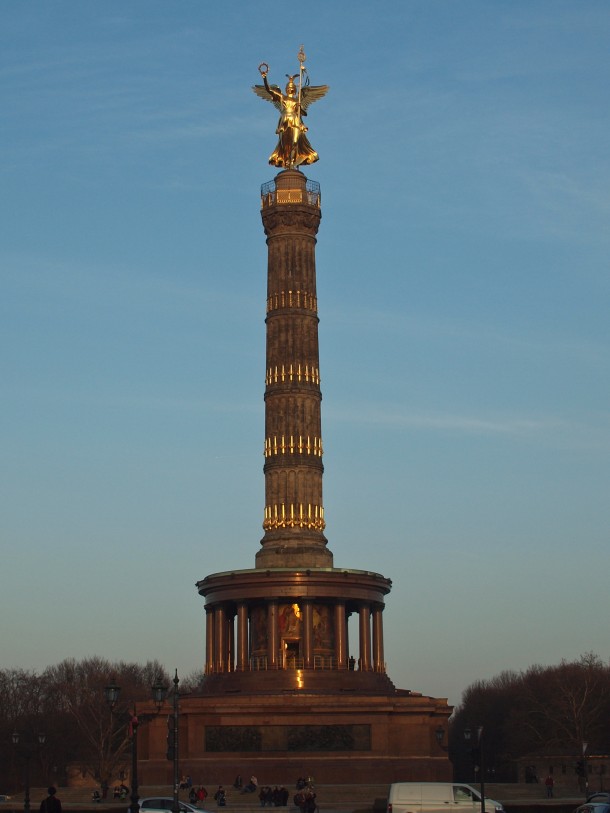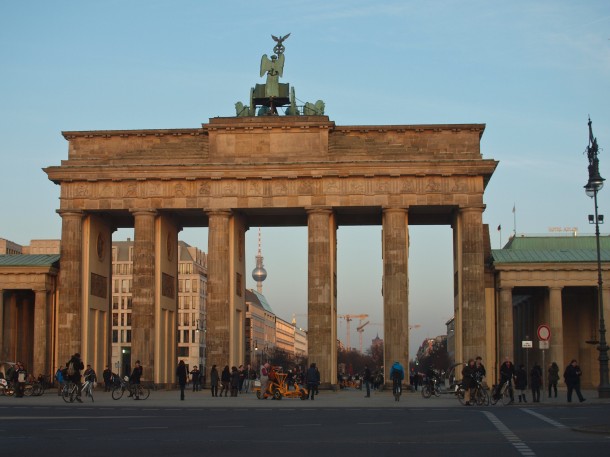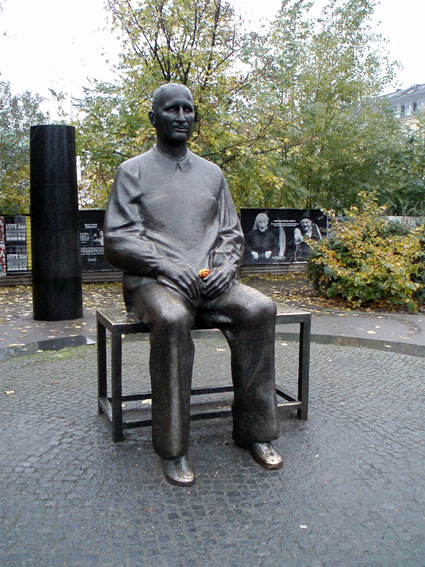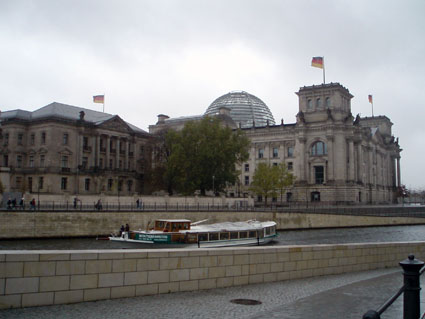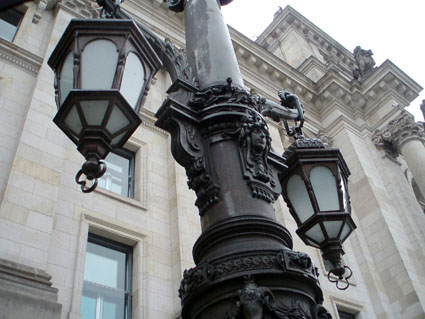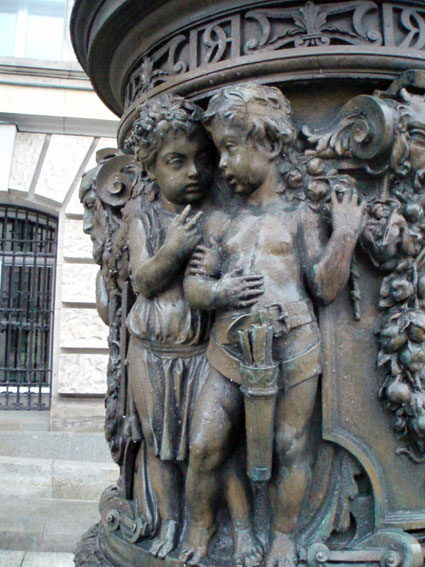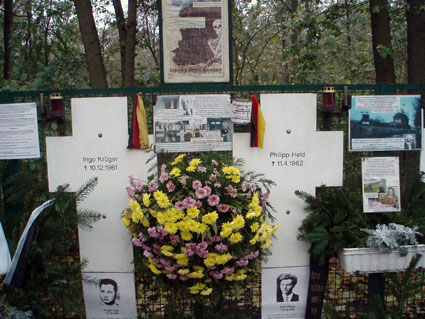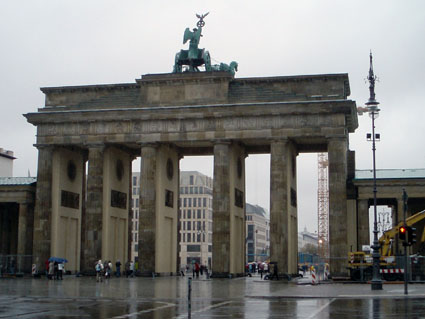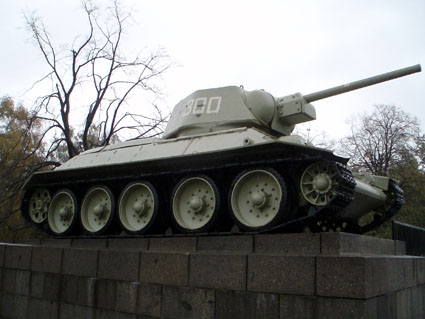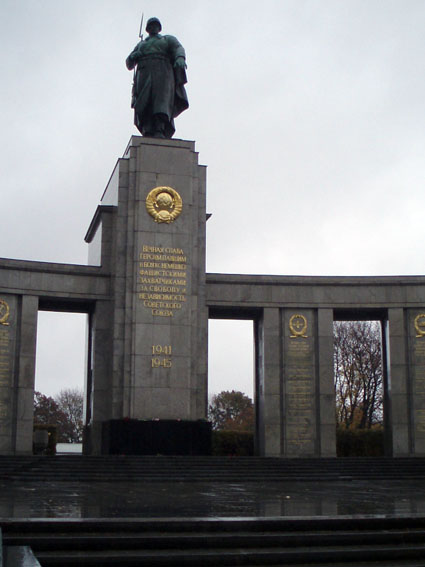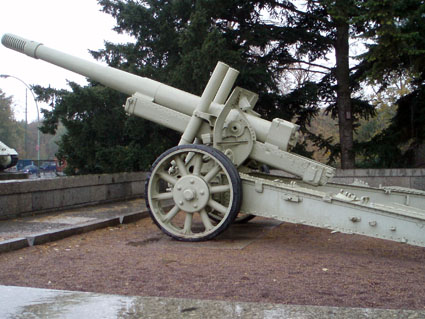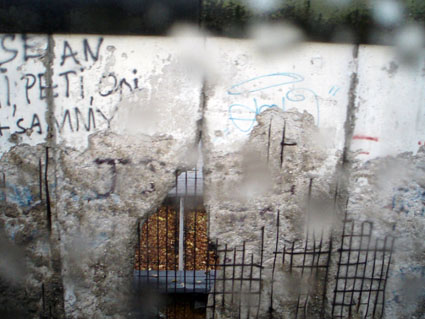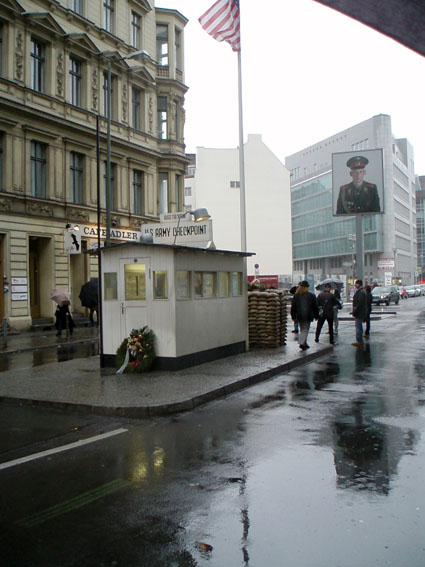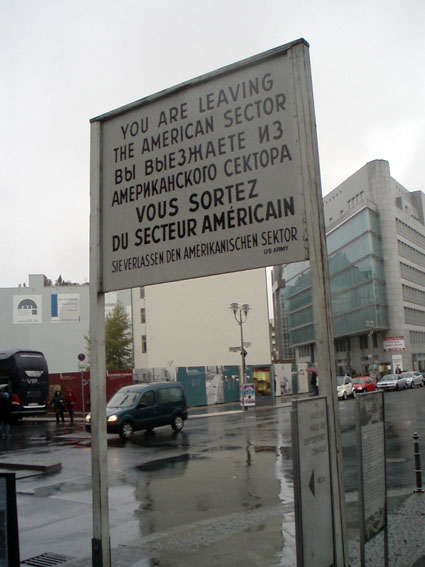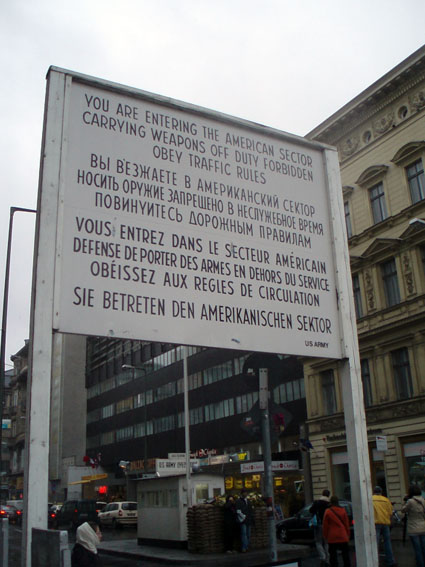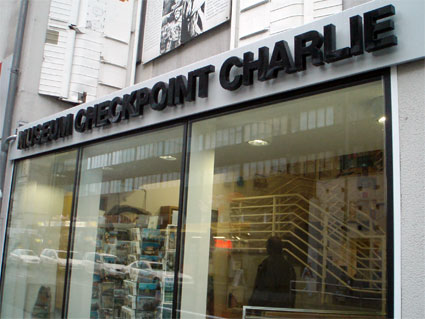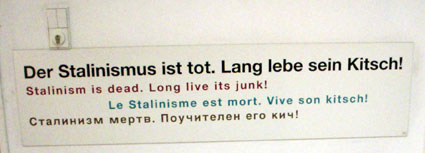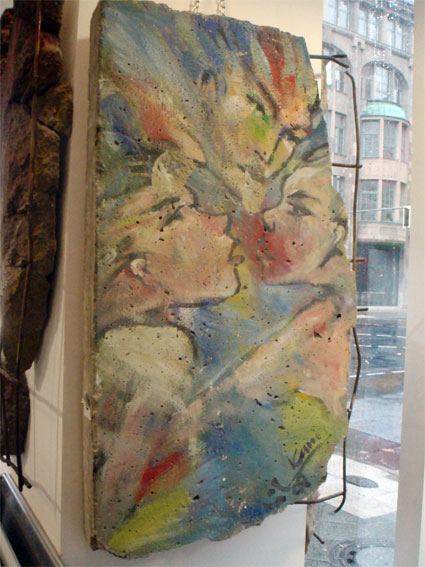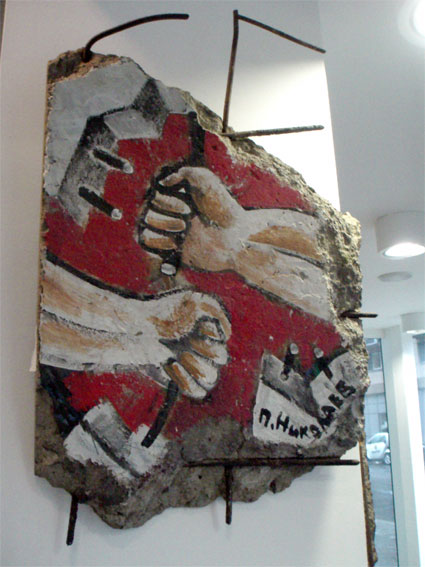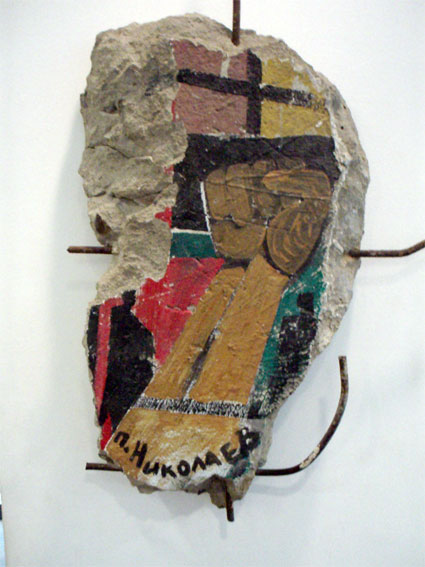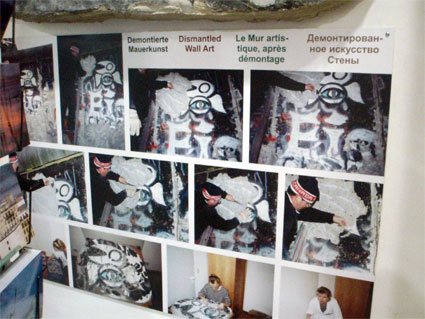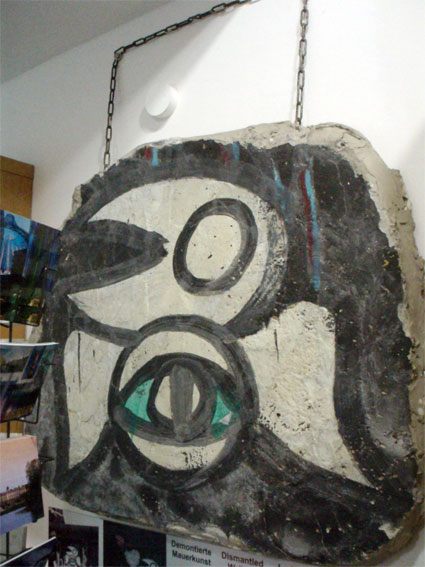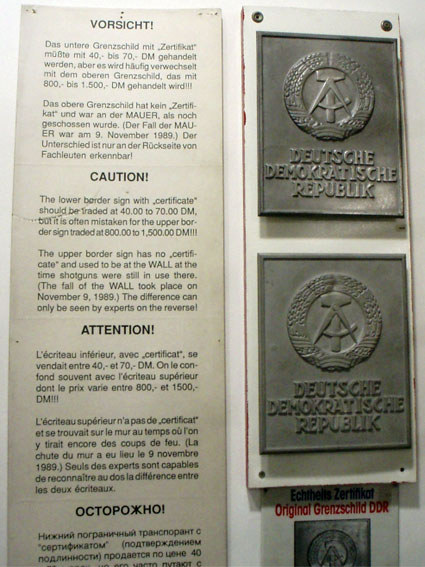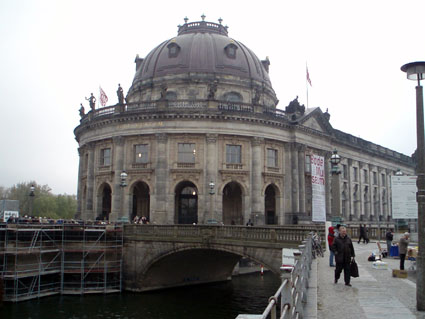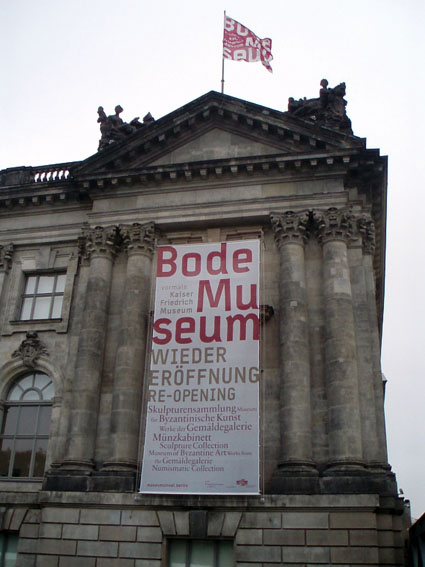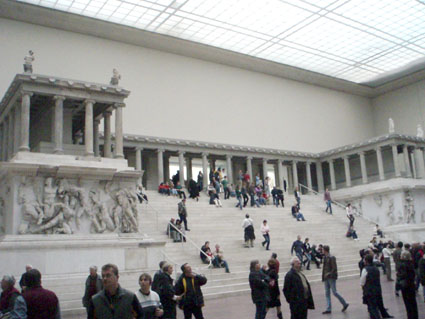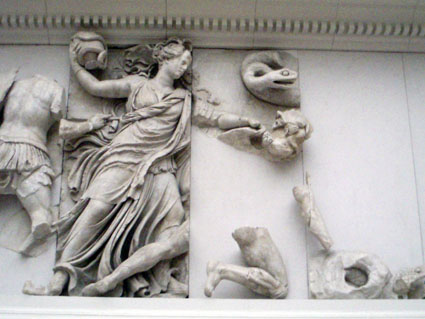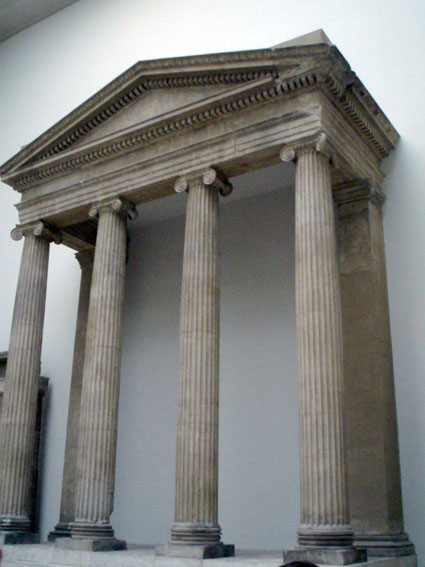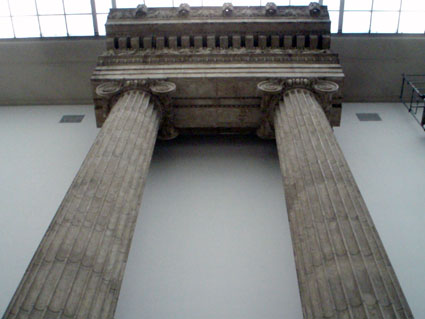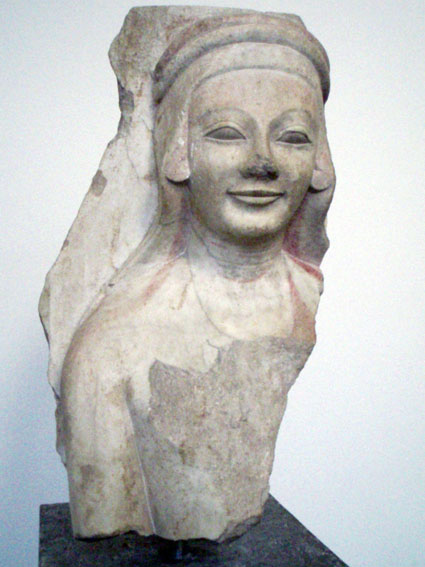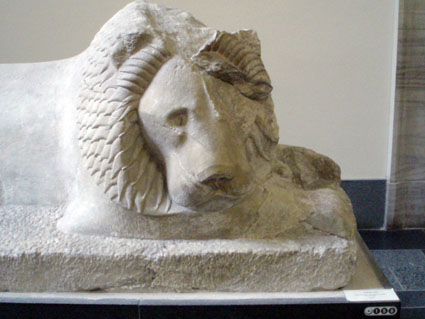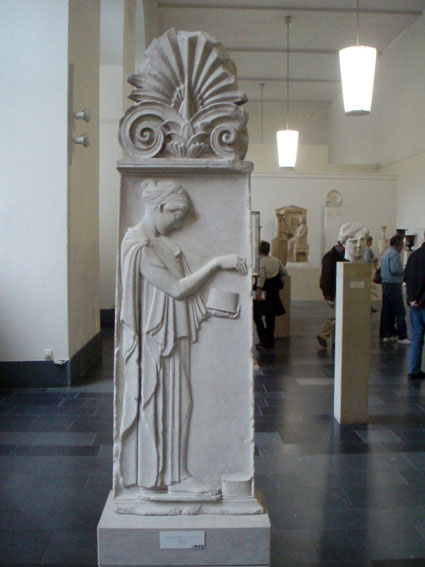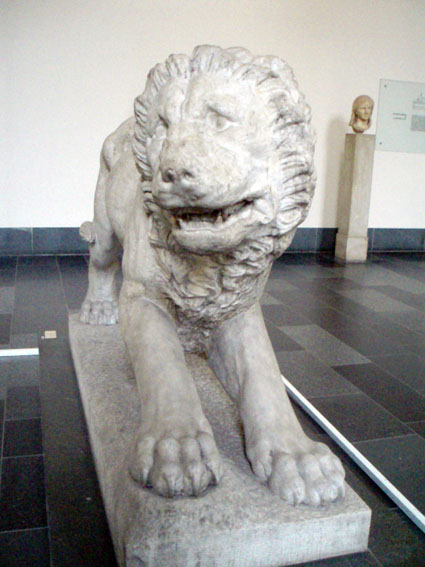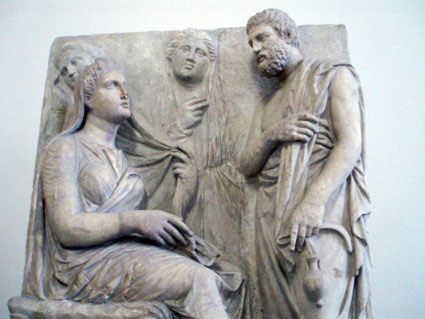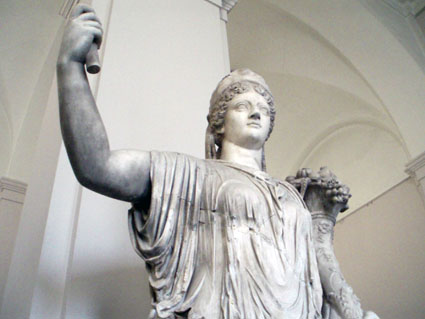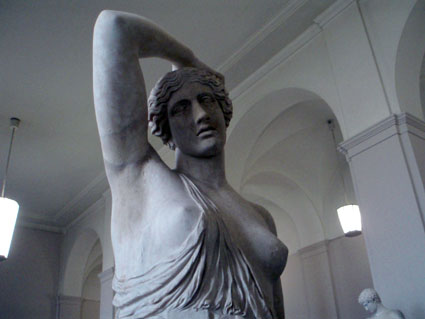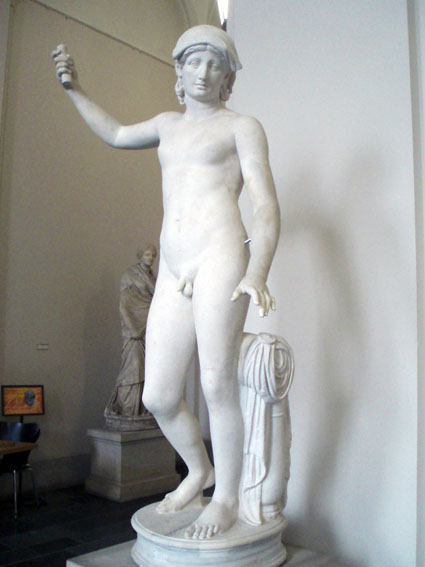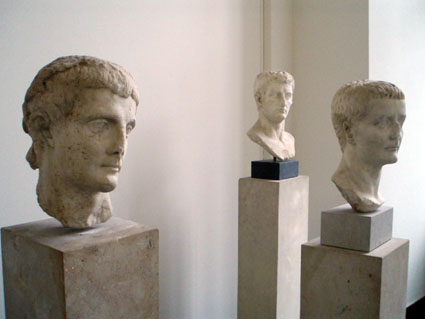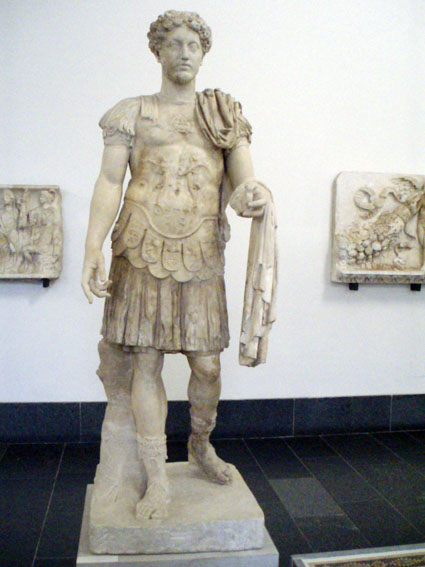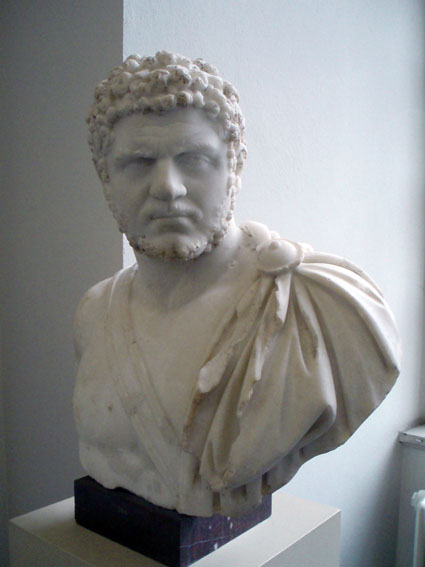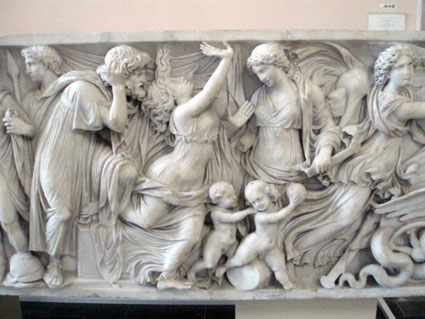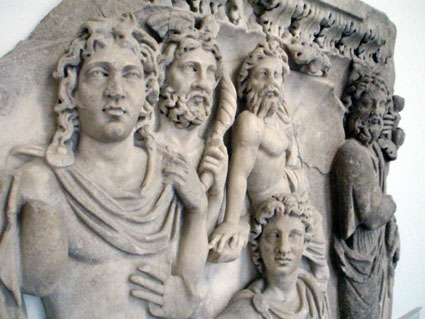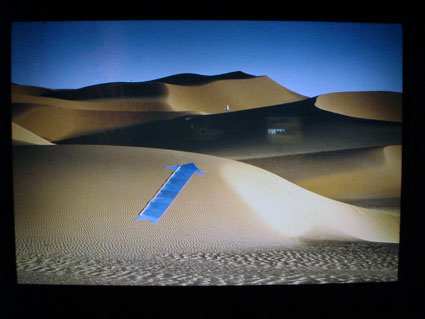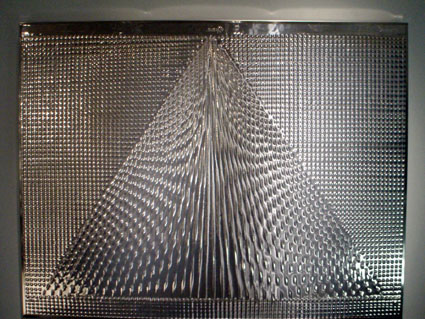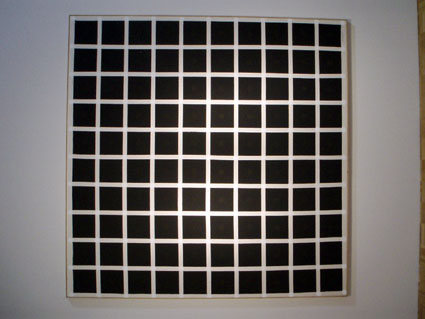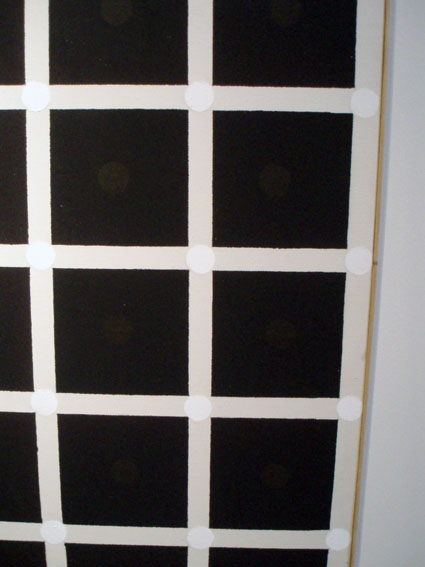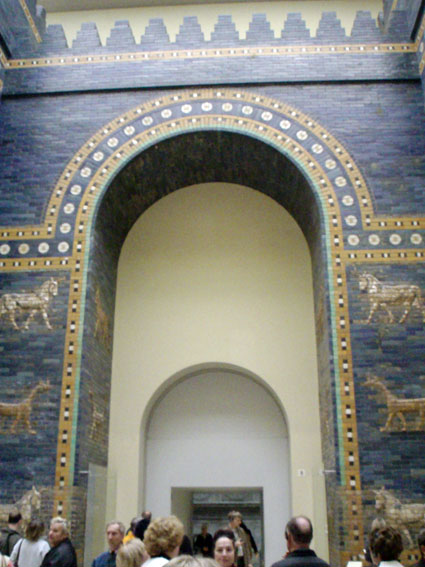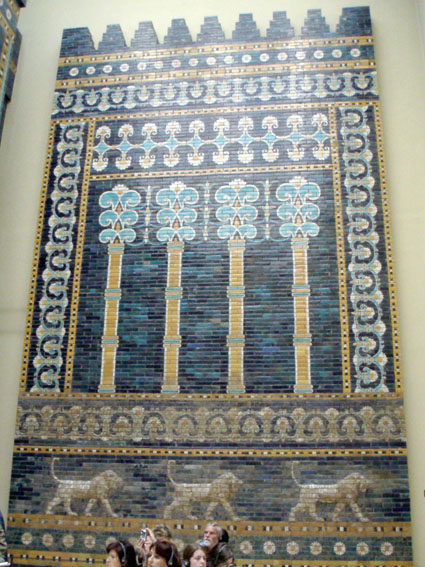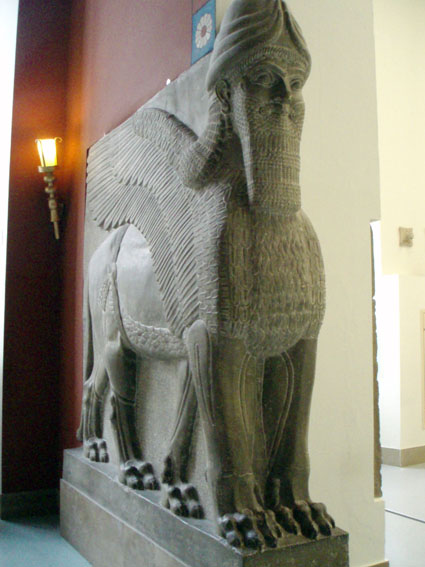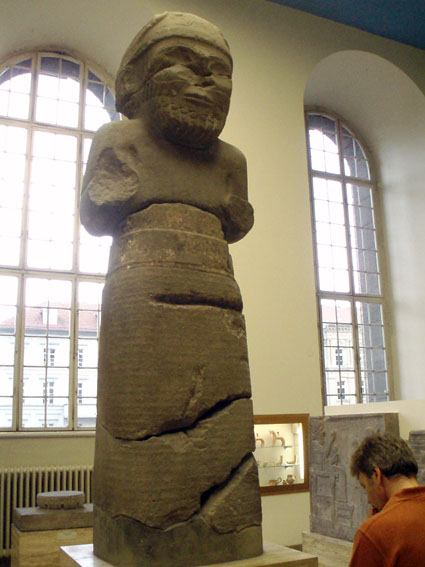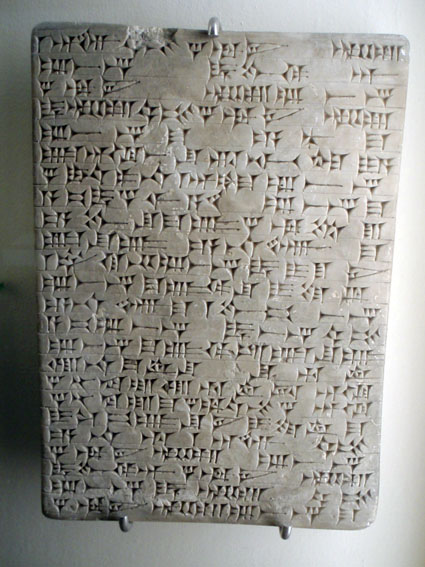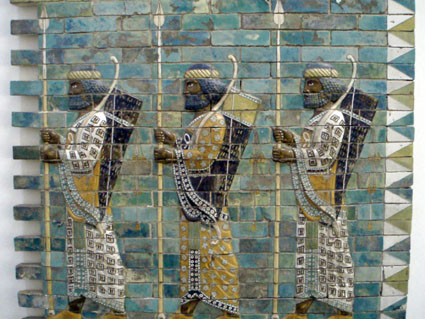I made the short walk to my hotel from the Pergamon Museum, and promptly put the rechargeable lithium battery in its charger. Then I went back downstairs and headed off to get a quick bite to eat. The museum was set to close at 6pm so I let the battery charge for about an hour and then made my way to the Altes Museum, where the Ägyptisches Collection is being housed temporarily while reconstruction work continues on the Neues Museum, where the whole of the collection will eventually be housed — its original venue in Berlin prior to WWII and the political division of Germany.
The Egyptian collection is located on the top floor of the building, where I paid my admission, doffed my coat and made my way inside.
Despite the lateness of the day, the museum was still busy, though not as busy as at had been at the Pergamon earlier in the day.
The first room is filled largely with the busts and statues of royal or related images. Here’s the photo-tour:
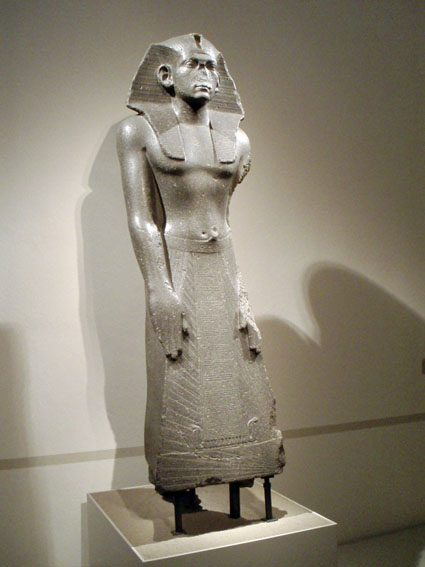
Statue of a Pharaoh Just Inside the Entrance
This is the first thing you see when you make your way through the entrance to the museum. A crowd of people gathered around it in a mix of awe and appreciation.
Receiving much less recognition was this small, impassive statue described as a baboon god. But in terms of history, this was arguably much more significant than the grand, kingly statue beside it, as it has, scratched in its base the catfish and hammer glyphs that represent the pharaoh Narmer, who is generally recognized as the first pharaoh of Ancient Egypt.
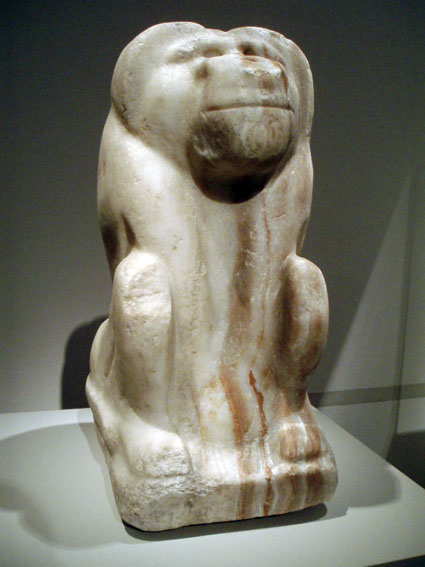
Baboon God Statue with Pharaoh Narmer’s Name Etched in its Base
A significant piece in the collection, and given pride of place near the entrance. I couldn’t help but find it suspect the difference between the quality of the piece and the relatively crudeness in which the name of the pharaoh was carved into its base. Hmmm.
Elsewhere in the room were other famous faces of various pharaohs, most dating to the time of the New Kingdom.
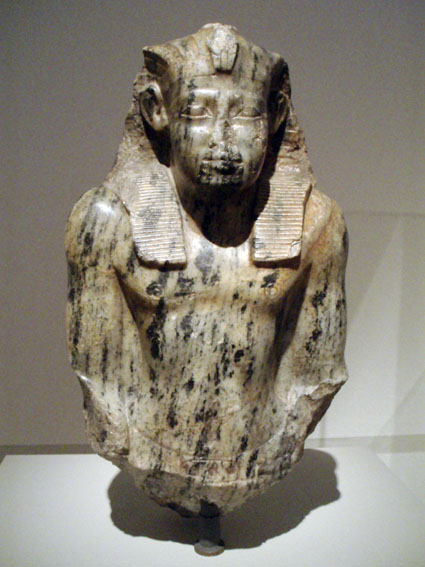
Bust of Sesostris I
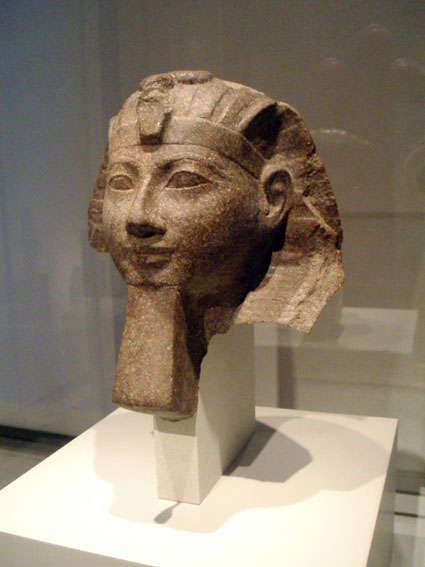
Fragmentary Statue Head of Hatshepsut
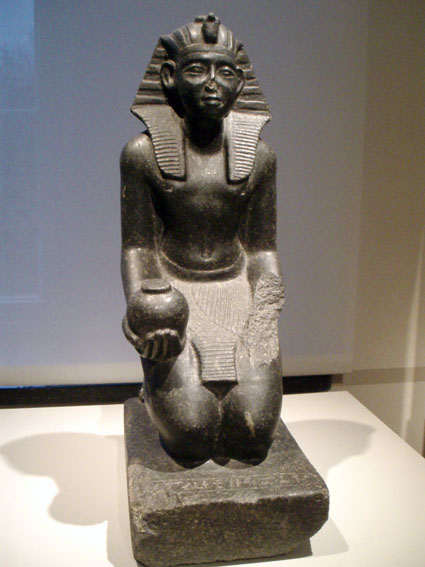
Kneeling Figure of Sobekhotep V
There is a division in the room and then you see a collection of statues primarily of private citizens, some with their families, others obviously important officials.
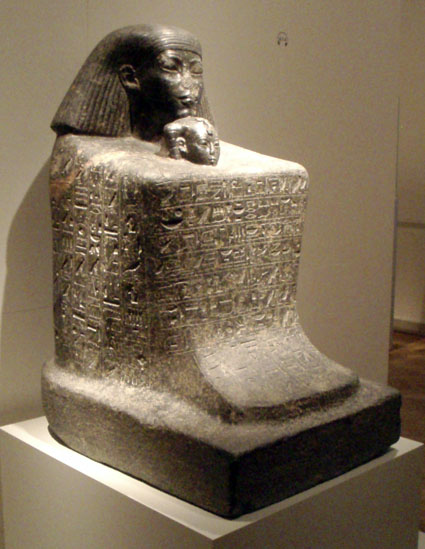
Block Statue of Senemut and Princess Neferure
This particular block statue (a popular form in Egypt used primarily by non-royals) struck me as particularly interesting, as the head of the young royal girl was also represented. This turned out to be a depiction of Senemut, who was tutor to princess Neferure, who was the daughter of the female pharaoh Hatshepsut. He is also credited with being the architect of several of Hatshepsut’s more impressive buildings, including her funerary complex — and also possibly the pharaoh’s lover.
There is an interesting mix of other pieces in the room, a real jumble of largely non-royals from several different eras and styles.
For example this late period statue of an unnamed official faces the head of Khaemwaset, one of the sons of Ramesses II.
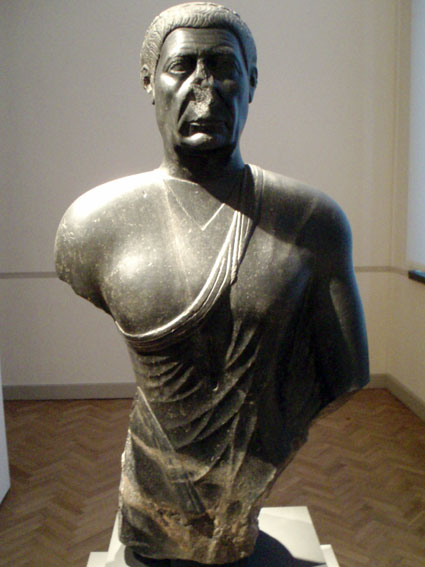
Late Period Egyptian Official
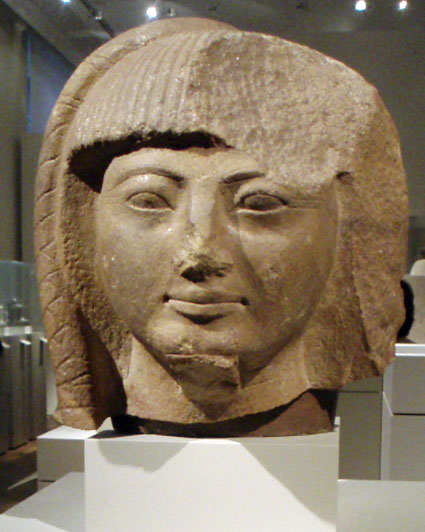
Prince Khaemwaset
The real gem in this part of the room was the famous “Berlin Green Head”, a finely crafted head carved in greywacke of some unknown late period official.
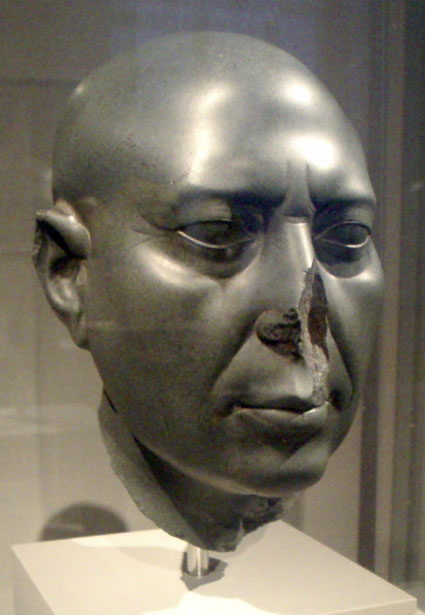
The Berlin Green Head
Just beside this last piece is the entrance to the hall containing the highly expressive art pieces from the Amarna period, which is recognized as the highlight of this museum’s collection.
A German-led expedition went to the long abandoned city of Amarna early in the last century, which was the seat of power for the “heretic” pharoah Akhenaten, who created a monotheistic cult of the disc of the sun god, called Aten. This is the first piece one sees when you enter the room: a broken relief depicting Amenhotep beside a falcon-headed Aten figure. He would soon after change his name to Akhenaten.
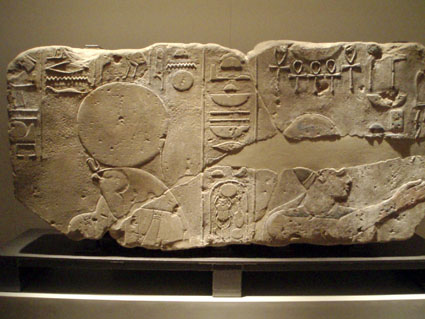
Falcon Aten and Amenhotep IV
The next depicted was the next thing that grabbed my attention: the head of Queen Tiye:
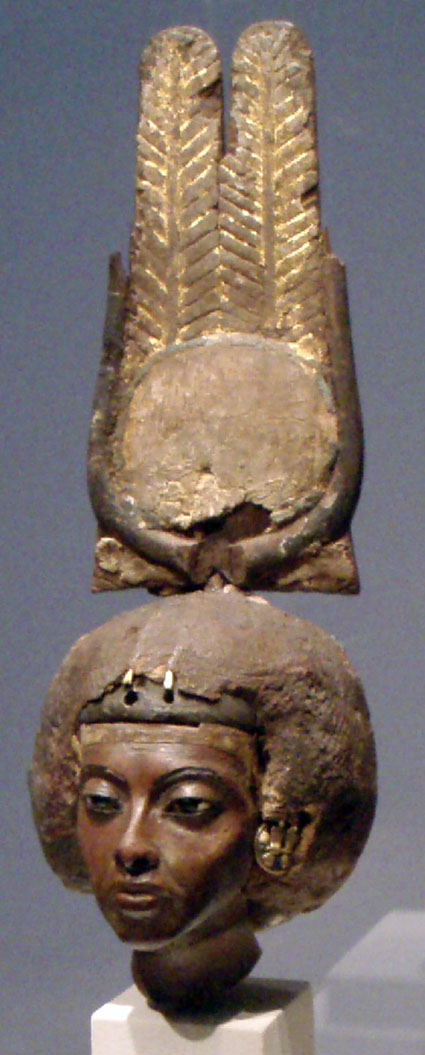
Head of Queen Tiye
This image has been endlessly reproduced, but I was surprised by its size it’s small. I had always thought it was life-size or near it, but the head is perhaps half life-sized, which makes the fine features of Queen Tiye, very much an individual, all the more impressive. Can’t help thinking she must have been formidable in person.
What follows are several plaster heads of Akhenaten and members of his court, presumably artist’s studies that were abandoned along with the rest of Amarna upon the death of the pharaoh.
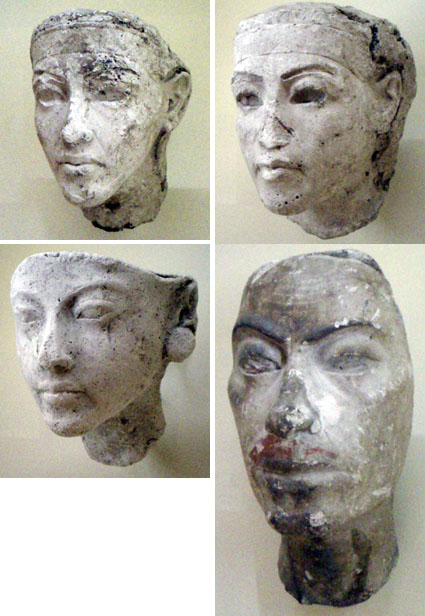
Plaster Heads of Akhenaten (x2), Nefertiti and Aye
They reminded me of the so-called “reserve heads” I had seen at an exhibition of Old Kingdom objects a few years back, and while that wasn’t the intention here, Akhenaten was clearly well supplied with plenty of them for his ba-soul (so the belief went) to find refuge in.
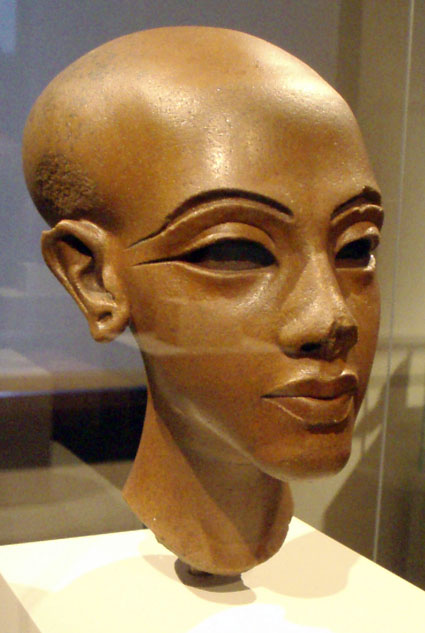
Elongated Head of an Amarna Princess
Theories have abounded on the strange shape of Akhenaten’s face as well as though of his family, including such exotic diseases as the “elephant man’s disease” and Marfan’s syndrome, but after looking at all of the lifelike busts, and the fact that the more exaggerated appearances tend to date to the later part of his rule, I can’t help but think that this was a stylistic difference, intended to make the king and his family appear “otherworldly”, something recognizably human, but exaggerated Don’t get me wrong, am not talking the silly flim-flammery of invoking Velikovskian aliens, but there has always been a tendency in art to emphasize certain physical features (just think of any of the pre-historic “Venus” figurines of Europe as an obvious example) and I would guess that the change in appearance has much more to do with exaggeration (and possibly caricature?) than any actual physical ailment. The mummy of Tutankhamen showed that his head was not markedly elongated, and he was almost certainly a descendant of Akhenaten. Until Akhenaten’s mummy is found (or identified) his ba-soul will have the last laugh.
The centerpiece (literally) of the Amarna exhibit is the famous bust of Queen Nefertiti.
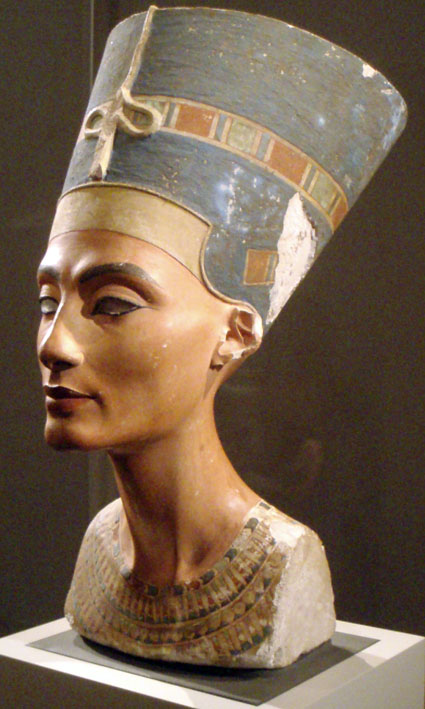
Bust of Queen Nefertiti
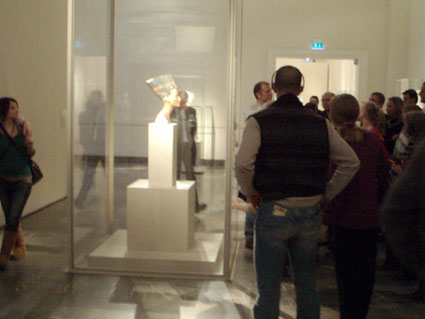
People Looking at Nefertiti Bust
A small crowd had understandably gathered around it, with a tour guide explaining things in German. The bust is striking, and so realistic that it must have been based on life — not a homogeneous, highly idealized image but clearly that of an individual. Which is why this has become a singular work of art which has been seen to typify that of Ancient Egypt, when in fact the opposite couldn’t be more true — it is a work from a very specific era when individual artistic expression was allowed to flourish. What came before and after did not express the same artistic range seen in the Amarna period.
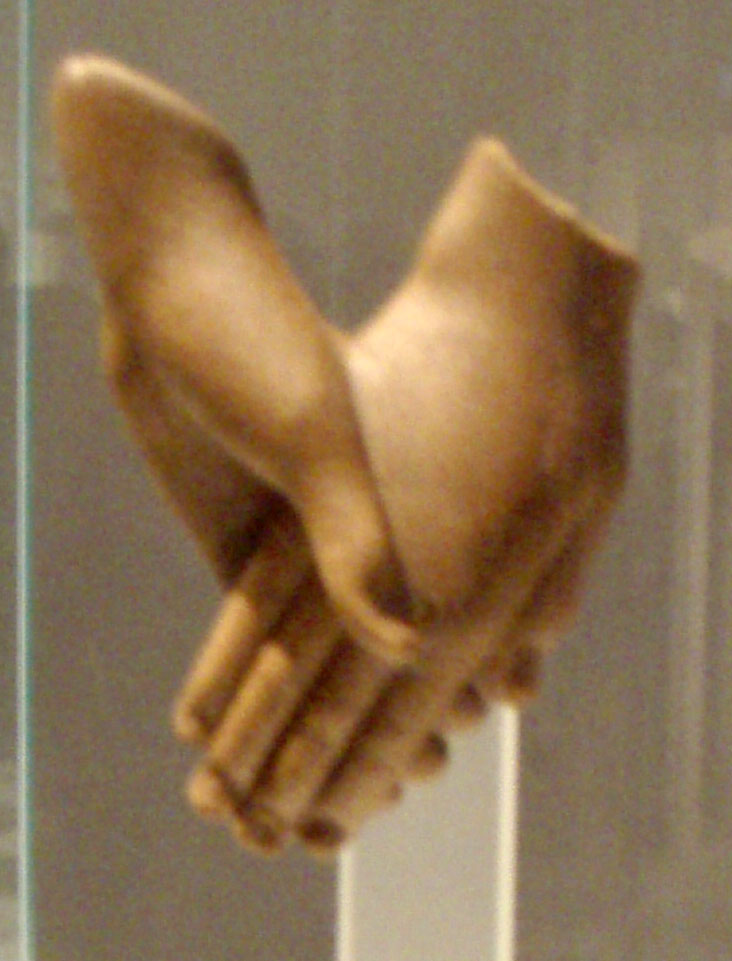
Clasped Hands from an Amarna-Era Statue
There were various other pieces dotted about the rest of the room, but this piece nicely concluded my visit: two hands holding each other, presumably of Akhenaten and Nefertiti, all that is left of some larger statue. At once the fragment is tender and evocative, though still clearly Egyptian in style.
After the highlights of the Amarna room anything else that would follow it would seem anti-climactic, but I was taken aback at the display in the next room of a number of papyri I knew the Berlin museum had these, but I didn’t expect to find them on display, even under the low-light conditions present in the room. Some of them were famous, such as the Papyrus Westcar, in which fantastic, magical tales are told to Khufu, the builder of the Great Pyramid. Then there’s the “Debate Between a Man and his Ba-Soul”, which is basically the first known piece of writing that deal with the topic of suicide (the Ba-soul suggests that it is not such a great idea). Then there are more colourful treatises detailing a soul’s passage to the underworld. I took plenty of (non-flash) photos, and will hopefully be able to stitch some of them together later in PhotoShop.
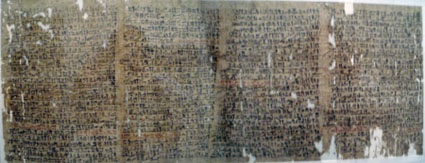
Westcar Papyrus Photo-montage (if you look closely you can see me taking the picture in reflected glass, twice

“Guide to the Afterlife for the Custodian of the Property of the Amon Temple Amonemwidja with Symbolic Illustrations Concerning the Dangers in the Netherworld”

“Guide to the Afterlife for the Custodian of the Property of the Goddess Mut Sesech with Symbolic Illustrations Concerning the Dangers in the Netherworld”
The doorway to the next room was framed by a series of mummy masks.
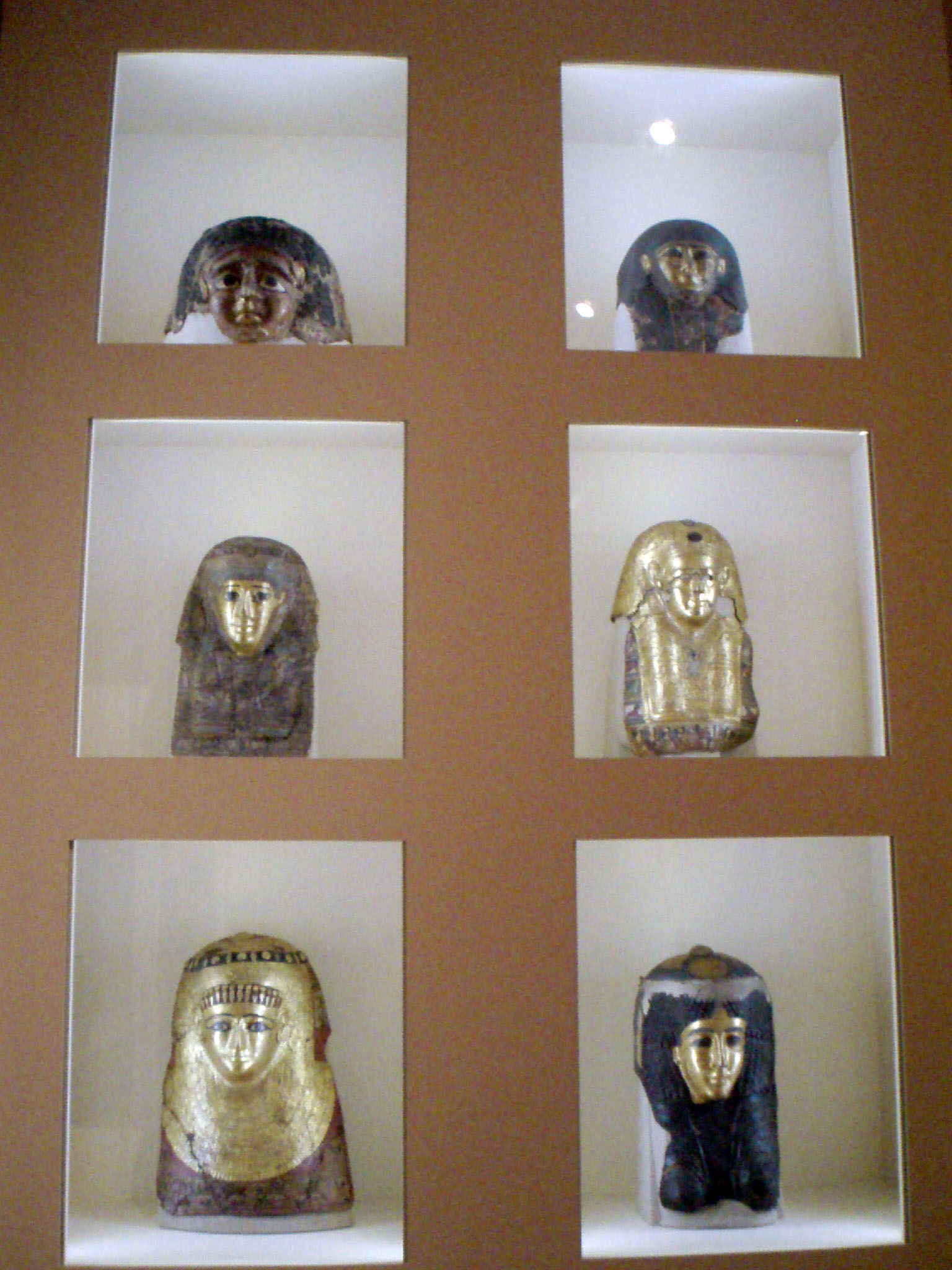
Mummy Masks Flanking Doorway
The room that followed contained several late period mummy cases and mummies (all wrapped up), including a family dating to the Greek or Roman period. These are the ones that include a painted portrait of the individual family member as they appeared in life. Couldn’t help but think of what my two young daughters would think about seeing mummies of children their age or younger.
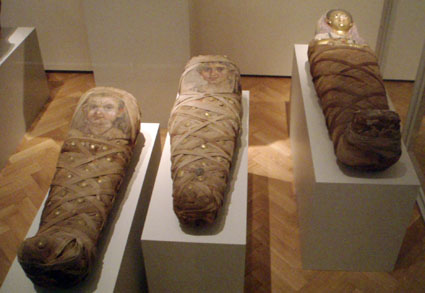
Mummies of Late Period Children
Was getting near the end of the Egyptian exhibit at this point, and the most impressive thing at the conclusion were a pair of statues of full-size lion headed goddesses Sekhmet, both clutching a very large ankh, the symbol of life, in their right hand. This particularly formidable-looking pair of goddesses were believed to protect against illness, and I had recently finished reading an article about their construction during the reign of Amenhotep III, who constructed a vast number of these statues. The thinking was that they were made during a time of repeated plagues, these statues ultimately a vain attempt at a preventative health measure against the pestilence which struck the land.
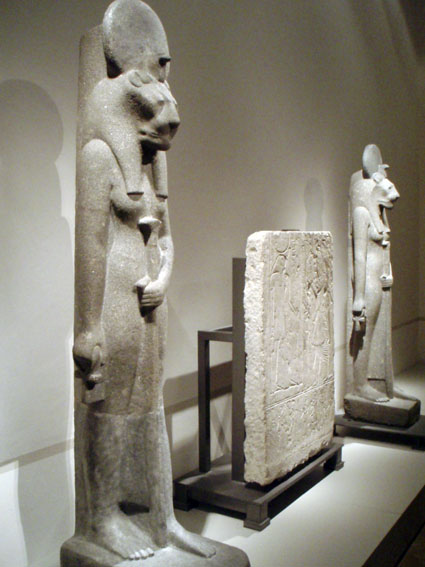
Pair of Sehkmet Statues
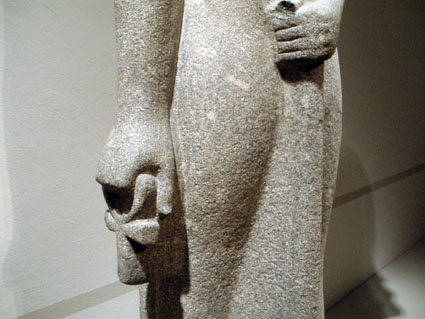
Close-up of Ankh
The exit immediately led to the bookstore, which had plenty of interesting titles, only a small portion of which were in English. Was most tempted by a stack of back issues of KMT, but they were all ones I had read at some point in the past. Was also tempted to pick up a plush blue hippo for my daughters, but I remembered the injunction from my wife not to bring back any more stuffies for them.
I thought that that was pretty much it, but it turned out that there were more Ancient Greek and Roman pieces downstairs. Entrance was through a circular atrium filled with statues of the gods. There was a skylight at the top of the dome which would have filled the atrium with light on a clear, sunny day, but it was late afternoon and the otherwise unlit room was gloomy and did not lend itself to picture-taking.
All of the explanatory text in the subsequent exhibit halls were exclusively in German, so I did not linger long over much of the rest of the exhibits. There were a few interesting busts of a few famous personages I either recognized directly or was able to figure out from the German labels.
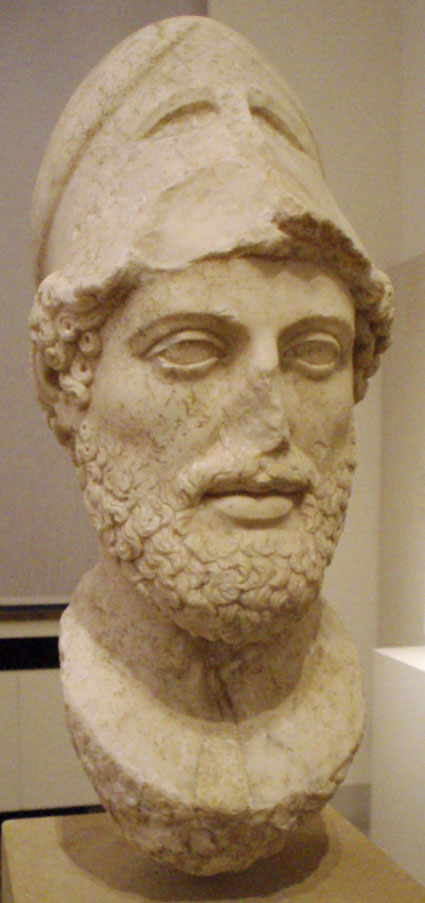
Bust of Pericles
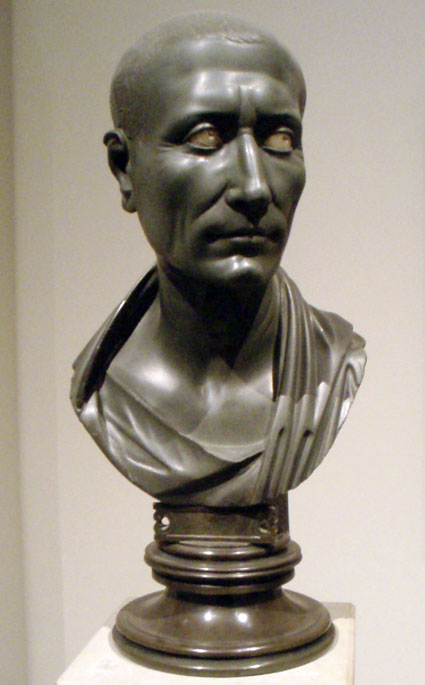
Doleful Looking Bust of Julius Caesar
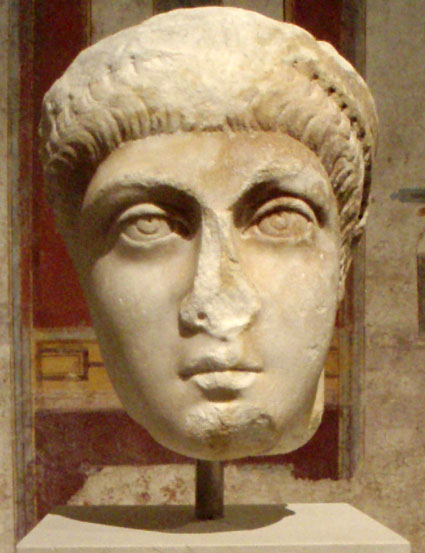
Bust of Emperor Arcadius
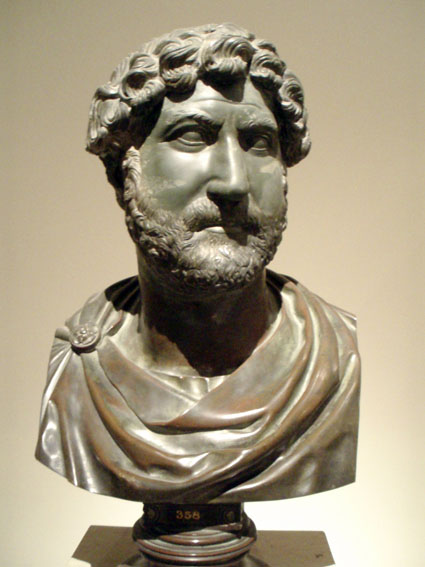
Bust of Emperor Hadrian
Getting somewhat museum-ed out by this stage, but still restless, I decided to go for a walk down Unter den Linden so that I could see the Brandenberg Gate. By this point my camera’s battery was on the verge of giving out, but I managed to take a few more interesting shots.
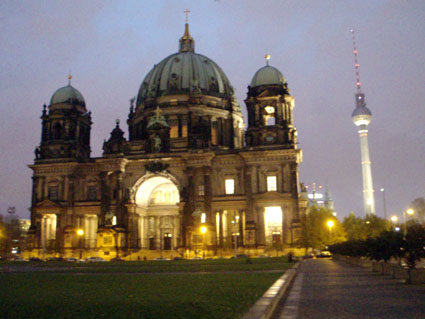
Berlin Cathedral and the the Fernsehturm (TV Tower)
While this picture above may seem like it was taken in late afternoon, it was taken when it was much darker outside. I managed to prop the camera against a tree and held the camera steady for the second or two it took to get the exposure. Beside me were a couple who taking pictures with a flash camera. Given that the cathedral was across the park, I would bet that my pic came out better than theirs. Visible to the left of the cathedral is the iconic TV tower, the Fernsehturm, made by the East German government and definitely Stalinist in look.
I walked down Unter den Linden, taking in the sights. Past the Crown Prince’s palace, then the historical museum, the State Opera House, Humbolt University (with a statue of the man in front of it), lots and lots of tourist shops, a couple of upscale car dealerships, then the Russian and British Embassies, and just beyond the construction cranes loomed the Brandenburg Gate.
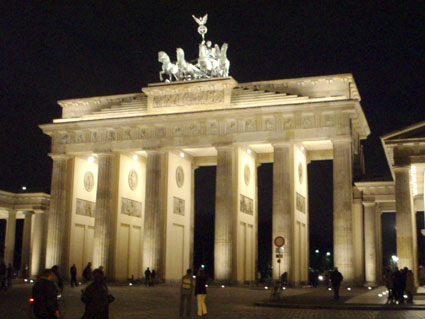
Brandenburg Gate at Night
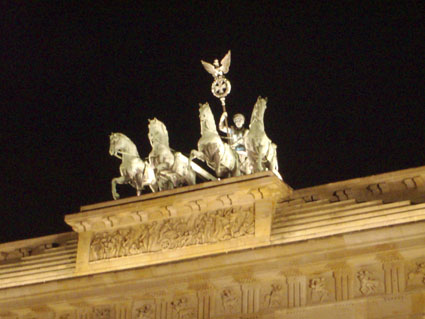
Close-up of the Quadriga on Top of the Brandenburg Gate
These were the last pics I took before my camera battery packed it in. Satisfied, I made my way back to my hotel room for the evening.
